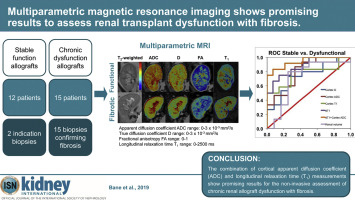当前位置:
X-MOL 学术
›
Kidney Int.
›
论文详情
Our official English website, www.x-mol.net, welcomes your
feedback! (Note: you will need to create a separate account there.)
Multiparametric magnetic resonance imaging shows promising results to assess renal transplant dysfunction with fibrosis.
Kidney International ( IF 14.8 ) Pub Date : 2019-10-30 , DOI: 10.1016/j.kint.2019.09.030 Octavia Bane 1 , Stefanie J Hectors 2 , Sonja Gordic 3 , Paul Kennedy 1 , Mathilde Wagner 1 , Amanda Weiss 4 , Rafael Khaim 5 , Zhengzi Yi 6 , Weijia Zhang 6 , Veronica Delaney 7 , Fadi Salem 8 , Cijiang He 5 , Madhav C Menon 5 , Sara Lewis 1 , Bachir Taouli 1
Kidney International ( IF 14.8 ) Pub Date : 2019-10-30 , DOI: 10.1016/j.kint.2019.09.030 Octavia Bane 1 , Stefanie J Hectors 2 , Sonja Gordic 3 , Paul Kennedy 1 , Mathilde Wagner 1 , Amanda Weiss 4 , Rafael Khaim 5 , Zhengzi Yi 6 , Weijia Zhang 6 , Veronica Delaney 7 , Fadi Salem 8 , Cijiang He 5 , Madhav C Menon 5 , Sara Lewis 1 , Bachir Taouli 1
Affiliation

|
Here we assessed the diagnostic value of a quantitative multiparametric magnetic resonance imaging (mpMRI) protocol for evaluation of renal allograft dysfunction with fibrosis. Twenty-seven renal transplant patients, including 15 with stable functional allografts (eGFR mean 71.5 ml/min/1.73m2), and 12 with chronic dysfunction/established fibrosis (eGFR mean 30.1 ml/min/1.73m2), were enrolled in this prospective single-center study. Sixteen of the patients had renal biopsy (mean 150 days) before the MRI. All patients underwent mpMRI at 1.5T including intravoxel-incoherent motion diffusion-weighted imaging, diffusion tensor imaging, blood oxygen level dependent (BOLD R2*) and T1 quantification. True diffusion D, pseudodiffusion D*, perfusion fraction PF, apparent diffusion coefficient (ADC), fractional anisotropy (FA), R2* and T1 were calculated for cortex and medulla. ΔT1 was calculated as (100x(T1 Cortex-T1 Medulla)/T1 Cortex). Test-retest repeatability and inter-observer reproducibility were assessed in four and ten patients, respectively. mpMRI parameters had substantial test-retest and interobserver repeatability (coefficient of variation under 15%), except for medullary PF and D* (coefficient of variation over 25%). Cortical ADC, D, medullary ADC and ΔT1 were all significantly decreased, while cortical T1 was significantly elevated in fibrotic allografts. Cortical T1 showed positive correlation to the Banff fibrosis and tubular atrophy scores. The combination of ΔT1 and cortical ADC had excellent cross-validated diagnostic performance for detection of chronic dysfunction with fibrosis. Cortical ADC and T1 had good performance for predicting eGFR decline at 18 months (4 or more ml/min/1.73m2/year). Thus, the combination of cortical ADC and T1 measurements shows promising results for the non-invasive assessment of renal allograft histology and outcomes.
中文翻译:

多参数磁共振成像显示了评估肾移植功能障碍伴纤维化的有希望的结果。
在这里,我们评估了定量多参数磁共振成像(mpMRI)协议对评估具有纤维化的肾脏同种异体功能障碍的诊断价值。该前瞻性纳入了27例肾移植患者,其中包括15例功能稳定的同种异体移植物(eGFR平均为71.5 ml / min / 1.73m2)和12例慢性功能障碍/已确立的纤维化(eGFR平均值为30.1 ml / min / 1.73m2)。单中心研究。MRI之前有16名患者进行了肾脏活检(平均150天)。所有患者均于1.5T接受mpMRI检查,包括体素不相干运动弥散加权成像,弥散张量成像,血氧水平依赖性(BOLD R2 *)和T1定量。真扩散D,伪扩散D *,灌注分数PF,表观扩散系数(ADC),分数各向异性(FA),计算皮质和髓质的R2 *和T1。ΔT1计算为(100x(T1 Cortex-T1 Medulla)/ T1 Cortex)。分别在四名和十名患者中评估了重测的可重复性和观察者间的可重复性。除髓质PF和D *(变异系数超过25%)外,mpMRI参数具有相当的重测和观察者间重复性(变异系数在15%以下)。在纤维化同种异体移植物中,皮质ADC,D,髓样ADC和ΔT1均显着降低,而皮质T1显着升高。皮质T1与Banff纤维化和肾小管萎缩评分呈正相关。ΔT1和皮质ADC的组合具有出色的交叉验证诊断性能,可用于检测慢性纤维化功能障碍。皮质ADC和T1在预测18个月eGFR下降方面表现良好(4毫升/分钟/1.73平方米/年)。因此,皮质ADC和T1测量的组合显示了对肾脏同种异体移植组织学和结果进行非侵入性评估的有希望的结果。
更新日期:2019-11-01
中文翻译:

多参数磁共振成像显示了评估肾移植功能障碍伴纤维化的有希望的结果。
在这里,我们评估了定量多参数磁共振成像(mpMRI)协议对评估具有纤维化的肾脏同种异体功能障碍的诊断价值。该前瞻性纳入了27例肾移植患者,其中包括15例功能稳定的同种异体移植物(eGFR平均为71.5 ml / min / 1.73m2)和12例慢性功能障碍/已确立的纤维化(eGFR平均值为30.1 ml / min / 1.73m2)。单中心研究。MRI之前有16名患者进行了肾脏活检(平均150天)。所有患者均于1.5T接受mpMRI检查,包括体素不相干运动弥散加权成像,弥散张量成像,血氧水平依赖性(BOLD R2 *)和T1定量。真扩散D,伪扩散D *,灌注分数PF,表观扩散系数(ADC),分数各向异性(FA),计算皮质和髓质的R2 *和T1。ΔT1计算为(100x(T1 Cortex-T1 Medulla)/ T1 Cortex)。分别在四名和十名患者中评估了重测的可重复性和观察者间的可重复性。除髓质PF和D *(变异系数超过25%)外,mpMRI参数具有相当的重测和观察者间重复性(变异系数在15%以下)。在纤维化同种异体移植物中,皮质ADC,D,髓样ADC和ΔT1均显着降低,而皮质T1显着升高。皮质T1与Banff纤维化和肾小管萎缩评分呈正相关。ΔT1和皮质ADC的组合具有出色的交叉验证诊断性能,可用于检测慢性纤维化功能障碍。皮质ADC和T1在预测18个月eGFR下降方面表现良好(4毫升/分钟/1.73平方米/年)。因此,皮质ADC和T1测量的组合显示了对肾脏同种异体移植组织学和结果进行非侵入性评估的有希望的结果。











































 京公网安备 11010802027423号
京公网安备 11010802027423号